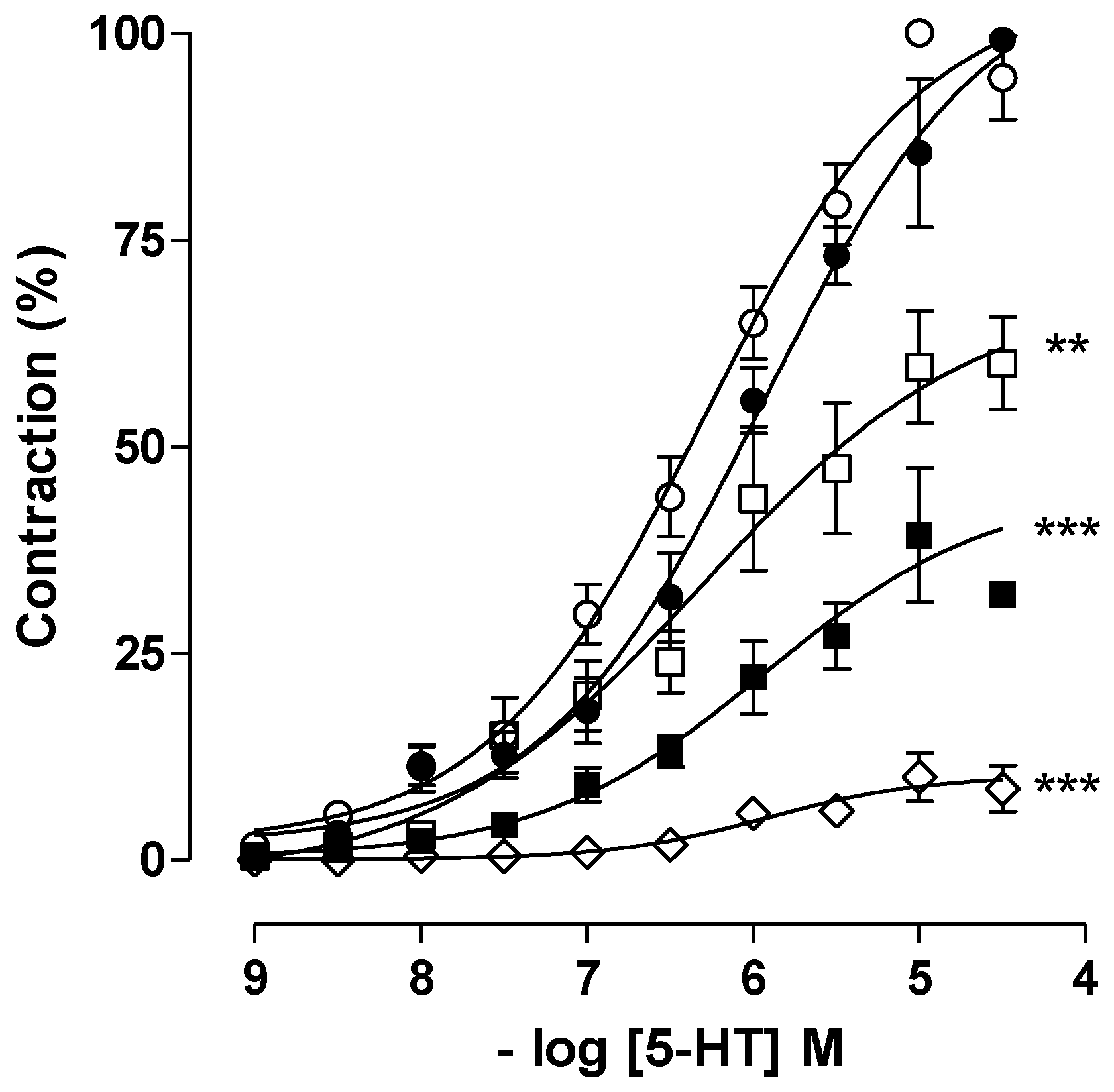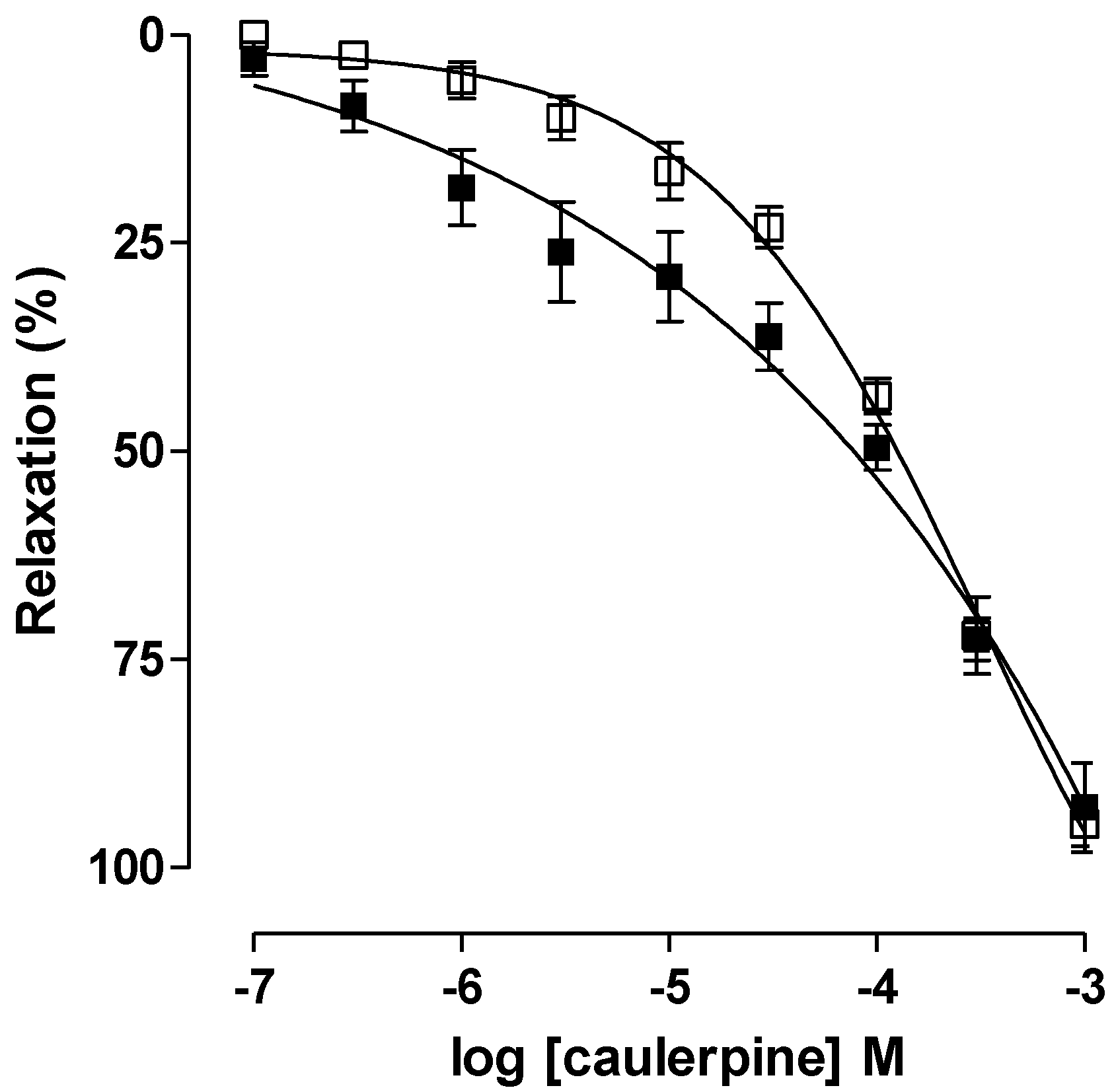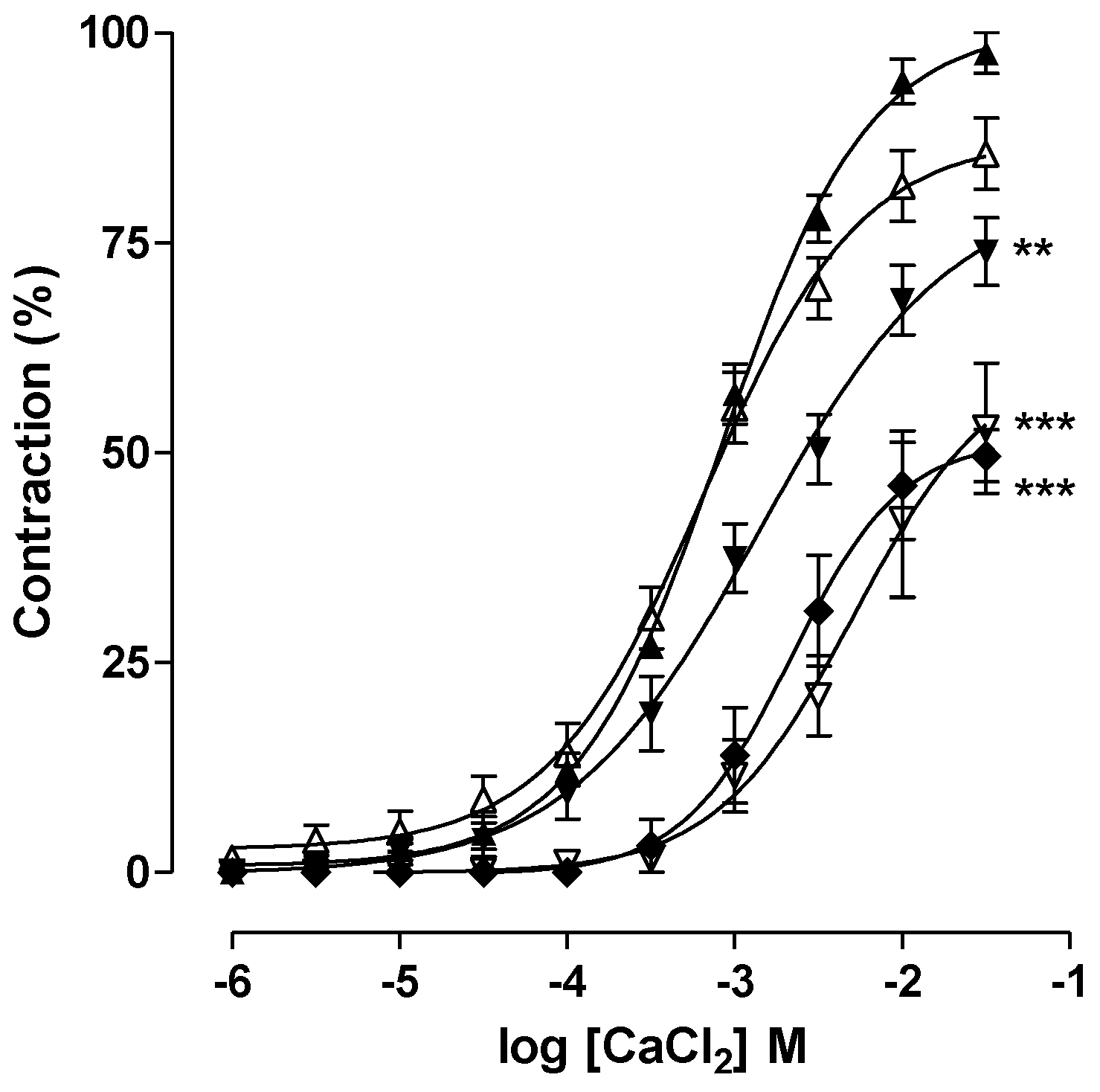Spasmolytic Effect of Caulerpine Involves Blockade of Ca2+ Influx on Guinea Pig Ileum
Abstract
:1. Introduction

2. Results and Discussion




3. Experimental Section
3.1. Isolation
3.2. Solutions and Drugs
3.3. Animals
3.4. Measurement of Contraction of Guinea Pig Ileum
3.5. Pharmacological Experiments
3.5.1. Effect of the Caulerpine on CCh-, Histamine- and Serotonin-Induced Phasic Contractions
3.5.2. Effect of Caulerpine on Serotonin-Induced Cumulative Contractions
3.5.3. Effect of the Caulerpine on KCl- or CCh-Induced Tonic Contractions
3.5.4. Effect of Caulerpine on CaCl2-Induced Contractions in Depolarizing Medium Nominally without Ca2+
3.6. Statistical Analysis
4. Conclusions
Acknowledgments
References
- Harvey, A.L. Natural products in drug discovery. Drug Discov. Today 2008, 13, 894–901. [Google Scholar] [CrossRef]
- Newman, D.J.; Cragg, G.M. Natural products as sources of new drugs over the 30 years from 1981 to 2010. J. Nat. Prod. 2012, 75, 311–335. [Google Scholar]
- Blunt, J.W.; Copp, B.R.; Keyzers, R.A.; Munro, M.H.; Prinsep, M.R. Marine natural products. Nat. Prod. Rep. 2012, 29, 144–222. [Google Scholar] [CrossRef]
- Molinski, T.F.; Dalisay, D.S.; Lievens, S.L.; Saludes, J.P. Drug development from marine natural products. Nat. Rev. Drug Discov. 2009, 81, 69–85. [Google Scholar]
- Lira, N.S.; Montes, R.C.; Tavares, J.F.; da Silva, M.S.; da Cunha, E.V.; de Athayde-Filho, P.F.; Rodrigues, L.C.; da Silva Dias, C.; Barbosa-Filho, J.M. Brominated compounds from marine sponges of the genus Aplysina and a compilation of their 13C NMR spectral data. Mar. Drugs 2011, 9, 2316–2368. [Google Scholar] [CrossRef]
- Essack, M.; Bajic, V.B.; Archer, J.A. Conotoxins that confer therapeutic possibilities. Mar. Drugs 2012, 10, 1244–1265. [Google Scholar] [CrossRef]
- De Almeida, C.L.; Falcão, H.S.; Lima, G.R.; Montenegro, C.A.; Lira, N.S.; de Athayde-Filho, P.F.; Rodrigues, L.C.; de Souza, M.F.; Barbosa-Filho, J.M.; Batista, L.M. Bioactivities from marine algae of the genus Gracilaria. Int. J. Mol. Sci. 2011, 12, 4550–4573. [Google Scholar] [CrossRef]
- Jimenez, P.C.; Wilke, D.V.; Ferreira, E.G.; Takeara, R.; de Moraes, M.O.; da Silveira, E.R.; da Cruz Lotufo, T.M.; Lopes, N.P.; Costa-Lotufo, L.V. Structure elucidation and anticancer activity of 7-oxostaurosporine derivatives from the Brazilian endemic tunicate Eudistoma vannamei. Mar. Drugs 2012, 10, 1092–1102. [Google Scholar] [CrossRef] [Green Version]
- Mayer, A.M.; Glaser, K.B.; Cuevas, C.; Jacobs, R.S.; Kem, W.; Little, R.D.; McIntosh, J.M.; Newman, D.J.; Potts, B.C.; Shuster, D.E. The odyssey of marine pharmaceuticals: A current pipeline perspective. Trends Pharmacol. Sci. 2010, 31, 255–265. [Google Scholar] [CrossRef]
- Hu, G.P.; Yuan, J.; Sun, L.; She, Z.G.; Wu, J.H.; Lan, X.J.; Zhu, X.; Lin, Y.C.; Chen, S.P. Statistical research on marine natural products based on data obtained between 1985 and 2008. Mar. Drugs 2011, 9, 514–525. [Google Scholar] [CrossRef]
- Gul, W.; Hamann, M.T. Indole alkaloid marine natural products: An established source of cancer drug leads with considerable promise for the control of parasitic, neurological and other diseases. Life Sci. 2005, 78, 442–453. [Google Scholar] [CrossRef]
- Güven, K.C.; Percot, A.; Sezik, E. Alkaloids in marine algae. Mar. Drugs 2010, 8, 269–284. [Google Scholar] [CrossRef]
- Rinehart, K.L.; Kobayashi, J.; Harbour, G.C.; Hughes, R.G.; Mizsak, S.A.; Scahill, T.A. Eudistomins C, E, K and L, potent antiviral compounds containing a novel oxathiazepine ring from Caribbean tunicate Eudistoma olivaceum. J. Am. Chem. Soc. 1984, 106, 1524–1526. [Google Scholar] [CrossRef]
- Kohmoto, S.; Kashman, Y.; McConnell, O.J.; Rinehart, K.L.; Wright, A.; Koehn, F. Dragmacidin, a new cytotoxic bis (indole) alkaloid from a deep water marine sponge, Dragmacidon sp. J. Org. Chem. 1988, 53, 3116–3118. [Google Scholar] [CrossRef]
- Bobzin, S.C.; Faulkner, D.J. Aromatic alkaloids from the marine sponge Chelonaplysilla sp. J. Org. Chem. 1991, 56, 4403–4407. [Google Scholar] [CrossRef]
- Souza, E.T.; Lira, D.P.; Queiroz, A.C.; Silva, D.J.C.; Aquino, A.B.; Mella, E.A.C.; Lorenzo, V.L.; Miranda, G.E.C.; Araújo-Júnior, J.X.; Chaves, M.C.O.; et al. The antinociceptive and anti-inflammatory activities of caulerpine, a bisindole alkaloid isolated from seaweeds of the genus Caulerpa. Mar. Drugs 2009, 7, 689–704. [Google Scholar] [CrossRef]
- Kobayashi, J.; Nakamura, H.; Ohizumi, Y.; Hirata, Y. Eudistomidin-A, a novel calmodulin antagonist from the Okinawan tunicate Eudistoma glaucus. Tetrahedron Lett. 1986, 27, 1191–1194. [Google Scholar] [CrossRef]
- Christophersen, C. Secondary metabolites from marine bryozoans. A review. Acta Chem. Scand. B 1985, 39, 517–529. [Google Scholar] [CrossRef]
- Lidgren, G.; Bohlin, L. Studies of Swedish marine organisms VII. A novel biologically active indole alkaloid from the sponge Geodia baretti. Tetrahedron Lett. 1986, 27, 3283–3284. [Google Scholar] [CrossRef]
- Aguilar-Santos, G.; Doty, M.S. Chemical Studies on Three Species of the Marine Algal Genus Caulerpa. In Drugs from the Sea; Freudenthal, H.D., Ed.; Marine Technology Society: Washington, DC, USA, 1968; pp. 173–176. [Google Scholar]
- Aguilar-Santos, G. Caulerpine, a new red pigment from green algae of the genus Caulerpa. J. Chem. Soc. C 1970, 6, 1842–1843. [Google Scholar]
- Anjaneyulu, A.S.R.; Prakash, C.V.S.; Mallavadhani, U.V. Sterols and terpenes of the marine green algal species Caulerpa racemosa and Codium decorticatum. J. Indian Chem. Soc. 1991, 68, 480. [Google Scholar]
- Yan, S.; Su, J.; Wang, Y.; Zeng, L. Studies on chemical constituents of Halimeda incrassata. Trop. Ocean. 1999, 18, 91–94. [Google Scholar]
- Govenkar, M.B.; Wahidulla, S. Constituents of Chondria armata. Phytochemistry 2000, 54, 979–981. [Google Scholar] [CrossRef]
- Ayyad, S.E.N.; Badria, F.A. Caulerpin: An antitumor indole alkaloid from Caulerpa racemosa. Alex. J. Pharm. Sci. 1994, 8, 217–219. [Google Scholar]
- Vairappan, C.S. Antibacterial activity of major secondary metabolities: Found in four species of edible green macroalgae genus Caulerpa. Asian J. Microbiol. Biotechnol. Environ. Sci. 2004, 6, 197–201. [Google Scholar]
- Mao, S.C.; Guo, Y.W.; Shen, X. Two novel aromatic valerenane-type sesquiterpenes from the Chinese green alga Caulerpa taxifolia. Bioorg. Med. Chem. Lett. 2006, 16, 2947–2950. [Google Scholar] [CrossRef]
- Liu, Y.; Morgan, J.B.; Coothankandaswamy, V.; Liu, R.; Jekabsons, M.B.; Mahdi, F.; Nagle, D.G.; Zhou, Y.D. The Caulerpa pigment caulerpine inhibits HIF-1 activation and mitochondrial respiration. J. Nat. Prod. 2009, 72, 2104–2109. [Google Scholar] [CrossRef]
- Macedo, N.R.P.V.; Ribeiro, M.S.; Villaça, R.C.; Ferreira, W.; Pinto, A.M.; Teixeira, V.L.; Cirne-Santos, C.; Paixão, I.C.N.P.; Giongo, V. Caulerpine as a potential antiviral drug against herpes simplex virus type 1. Braz. J. Pharmacogn. 2012, 22, 861–867. [Google Scholar]
- Cavalcante-Silva, L.H.A.; Barbosa Brito da Matta, C.; de Araújo, M.V.; Barbosa-Filho, J.M.; Pereira de Lira, D.; de Oliveira Santos, B.V.; de Miranda, G.E.C.; Alexandre-Moreira, M.S. Antinociceptive and anti-inflammatory activities of crude methanolic extract of red alga Bryothamnion triquetrum. Mar. Drugs 2012, 10, 1977–1992. [Google Scholar] [CrossRef]
- Brito da Matta, C.B.; de Souza, É.T.; de Queiroz, A.C.; de Lira, D.P.; de Araújo, M.V.; Cavalcante-Silva, L.H.A.; de Miranda, G.E.C.; de Araújo-Júnior, J.X.; Barbosa-Filho, J.M.; de Oliveira Santos, B.V.; et al. Antinociceptive and anti-inflammatory activity from algae of the genus Caulerpa. Mar. Drugs 2011, 9, 307–318. [Google Scholar] [CrossRef]
- Souza, E.T.; Queiroz, A.C.; Miranda, G.E.C.; Lorenzo, V.P.; Silva, E.F.; Freire-Dias, T.L.M.; Cupertino-Silva, Y.K.; Melo, G.M.A.; Chaves, M.C.O.; Barbosa-Filho, J.M.; et al. Antinociceptive activities of crude methanolic extract and phases, n-butanolic, chloroformic and ethyl acetate from Caulerpa racemosa (Caulerpaceae). Braz. J. Pharmacogn. 2009, 19, 115–120. [Google Scholar]
- Sorkin, L.S.; Wallace, M.S. Acute pain mechanisms. Surg. Clin. North Am. 1999, 79, 213–229. [Google Scholar] [CrossRef]
- Berridge, M.J. Smooth muscle cell calcium activation mechanisms. J. Physiol. 2008, 586, 5047–5061. [Google Scholar] [CrossRef]
- Silva, B.A.; de Araújo, A.P.; Mukherjee, R.; Chiappeta, A.D. Bisnordihydrotoxiferine and vellosimine from Strychnos divaricans root: Spasmolytic properties of bisnordihydrotoxiferine. Phytother. Res. 1993, 7, 419–424. [Google Scholar] [CrossRef]
- Diniz, M.F.F.M.; Silva, B.A.; Mukherjee, R. Spasmolytic actions of the new indole alkaloid trinervine from Strychnos trinervis root. Phytomedicine 1994, 1, 205–207. [Google Scholar] [CrossRef]
- Gutierrez, S.J.; Claudino, F.S.; Silva, B.A.; Câmara, C.A.; Almeida, R.N.; Souza, M.F.V.; Silva, M.S.; da-Cunha, E.V.; Barbosa-Filho, J.M. Nb-benzoyltryptamine derivatives with relaxant activity in guinea-pig ileum. Farmaco 2005, 60, 475–477. [Google Scholar] [CrossRef]
- Ash, A.S.; Schild, H.O. Receptors mediating some actions of histamine. Br. J. Pharmacol. Chemother. 1966, 27, 427–439. [Google Scholar] [CrossRef]
- Ehlert, F.J.; Sawyer, G.W.; Esqueda, E.E. Contractile role of M2 and M3 muscarinic receptors in gastrointestinal smooth muscle. Life Sci. 1999, 64, 387–394. [Google Scholar] [CrossRef]
- Berridge, M.J.; Bootman, M.D.; Roderick, H.L. Calcium signalling: Dynamics, homeostasis and remodelling. Nat. Rev. Mol. Cell Biol. 2003, 4, 517–529. [Google Scholar] [CrossRef] [Green Version]
- Engel, G.; Hoyer, D.; Kalkman, H.O.; Wick, M.B. Identification of 5HT2-receptors on longitudinal muscle of the guinea pig ileum. J. Recept. Res. 1984, 4, 113–126. [Google Scholar]
- Fox, A.; Morton, I.K. An examination of the 5-HT3 receptor mediating contraction and evoked [3H]-acetylcholine release in the guinea-pig ileum. Br. J. Pharmacol. 1990, 101, 553–558. [Google Scholar] [CrossRef]
- Hoyer, D.; Hannon, J.P.; Martin, G.R. Molecular, pharmacological and functional diversity of 5-HT receptors. Pharmacol. Biochem. Behav. 2002, 71, 533–554. [Google Scholar] [CrossRef]
- Bolton, T.B. Mechanism of action of transmitters and other substances on smooth-muscle. Physiol. Rev. 1979, 59, 606–718. [Google Scholar]
- Abdel-Latif, A.A. Calcium-mobilizing receptors, polyphosphoinositides, generation of second messengers and contraction in the mammalian iris smooth muscle: Historical perspectives and current status. Life Sci. 1989, 45, 757–786. [Google Scholar] [CrossRef]
- Honda, K.; Takano, Y.; Kamiya, H. Involvement of protein kinase C in muscarinic agonist-induced contractions of guinea pig ileal longitudinal muscle. Gen. Pharmacol. 1996, 27, 957–961. [Google Scholar] [CrossRef]
- Nouailhetas, V.L.; Shimuta, S.I.; Paiva, A.C.; Paiva, T.B. Calcium and sodium dependence of the biphasic response of the guinea-pig ileum to agonists. Eur. J. Pharmacol. 1985, 116, 41–47. [Google Scholar] [CrossRef]
- Triggle, C.R.; Swamy, V.C.; Triggle, D.J. Calcium antagonists and contractile responses in rat vas deferens and guinea pig ileal smooth muscle. Can. J. Physiol. Pharmacol. 1979, 57, 804–818. [Google Scholar] [CrossRef]
- Rembold, C.M. Electromechanical and Pharmacomechanical Coupling. In Biochemistry of Smooth Contraction; Bárány, M., Ed.; Academic Press: San Diego, CA, USA, 1996; pp. 227–239. [Google Scholar]
- Neubig, R.R.; Spedding, M.; Kenakin, T.; Christopoulos, A. International Union of Pharmacology Committee on Receptor Nomenclature and Drug Classification. XXXVIII. Update on terms and symbols in quantitative pharmacology. Pharmacol. Rev. 2003, 55, 597–606. [Google Scholar] [CrossRef]
- Dunne, A. Comparison of individual and cumulative dose-response curves [proceedings]. Br. J. Pharmacol. 1979, 67, 491–492. [Google Scholar]
© 2013 by the authors; licensee MDPI, Basel, Switzerland. This article is an open access article distributed under the terms and conditions of the Creative Commons Attribution license (http://creativecommons.org/licenses/by/3.0/).
Share and Cite
Cavalcante-Silva, L.H.A.; De Carvalho Correia, A.C.; Barbosa-Filho, J.M.; Da Silva, B.A.; De Oliveira Santos, B.V.; De Lira, D.P.; Sousa, J.C.F.; De Miranda, G.E.C.; De Andrade Cavalcante, F.; Alexandre-Moreira, M.S. Spasmolytic Effect of Caulerpine Involves Blockade of Ca2+ Influx on Guinea Pig Ileum. Mar. Drugs 2013, 11, 1553-1564. https://doi.org/10.3390/md11051553
Cavalcante-Silva LHA, De Carvalho Correia AC, Barbosa-Filho JM, Da Silva BA, De Oliveira Santos BV, De Lira DP, Sousa JCF, De Miranda GEC, De Andrade Cavalcante F, Alexandre-Moreira MS. Spasmolytic Effect of Caulerpine Involves Blockade of Ca2+ Influx on Guinea Pig Ileum. Marine Drugs. 2013; 11(5):1553-1564. https://doi.org/10.3390/md11051553
Chicago/Turabian StyleCavalcante-Silva, Luiz Henrique Agra, Ana Carolina De Carvalho Correia, José Maria Barbosa-Filho, Bagnólia Araújo Da Silva, Bárbara Viviana De Oliveira Santos, Daysianne Pereira De Lira, Jéssica Celestino Ferreira Sousa, George Emmanuel C. De Miranda, Fabiana De Andrade Cavalcante, and Magna Suzana Alexandre-Moreira. 2013. "Spasmolytic Effect of Caulerpine Involves Blockade of Ca2+ Influx on Guinea Pig Ileum" Marine Drugs 11, no. 5: 1553-1564. https://doi.org/10.3390/md11051553
APA StyleCavalcante-Silva, L. H. A., De Carvalho Correia, A. C., Barbosa-Filho, J. M., Da Silva, B. A., De Oliveira Santos, B. V., De Lira, D. P., Sousa, J. C. F., De Miranda, G. E. C., De Andrade Cavalcante, F., & Alexandre-Moreira, M. S. (2013). Spasmolytic Effect of Caulerpine Involves Blockade of Ca2+ Influx on Guinea Pig Ileum. Marine Drugs, 11(5), 1553-1564. https://doi.org/10.3390/md11051553



